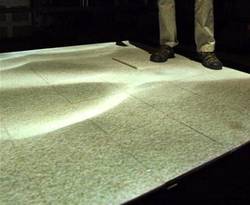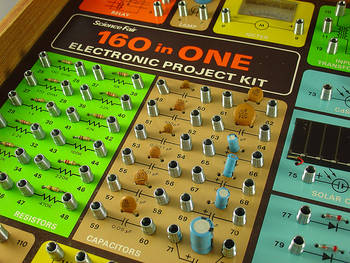The Latest from Boing Boing |  |
- Goodhart's Law: Once you measure something, it changes
- All of Gopherspace as a single download
- Cream of Wheat 1956 ad: breakfast is better with ice-cream!
- Timeline of Facebook privacy policy: from reasonable (2005) to apocalyptic (2010)
- Augmented reality feedback flooring
- Geocities-izer: make any webpage look like it was made by a 13 year-old in 1996
- Raised by Radio Shack
- Top US psychiatric pharmaceuticals, 2009 edition
- Adam Ant comeback
- Flintstones hawking cigarettes
- Nate Silver on the British election
- Chevron demands "Crude" filmmaker hand over footage
- Gordon Brown apologizes to bigoted woman
- Iraq: detainees testify of systemic torture at secret prison
- Nazi pedophile, torturer, cult leader in Chile dies
- Male fairies enter Pixie Hollow
- Jason Rohrer's art/game essentials headed to Nintendo DS
- Could drone pilots be tried for war crimes?
- Lazyweb request: need Mac software to digitize LP collection
- Ze Frank urges you to breathe
- Canadian record industry won't say what it wants
- Music industry spokesman loves child porn
- Mississippi school purges top student from yearbook for being lesbian
- Zero-G founder, X-Prize guy, and spacevangelist Diamandis profiled on Reason TV
- HP acquires Palm for $1.2 billion
- The state of hotel WiFi, 2010
- Gallery of real and imaginary pest killer packaging
- Hand-drawn maps on display
- Twetiquette Cops (and @johncusack) in NYT
- Of Flattened Flora and Expulsion Cavities: The crop circle controversy continues
| Goodhart's Law: Once you measure something, it changes Posted: 29 Apr 2010 05:03 AM PDT Goodhart's Law is one of those neat formulations that codifies something I've been trying to put my finger on for years: "once a social or economic indicator or other surrogate measure is made a target for the purpose of conducting social or economic policy, then it will lose the information content that would qualify it to play such a role." That is, once you start measuring GDP as a way to gauging social welfare, people will start to figure out ways to make GDP go up without improving social welfare (say, by swapping dirty financial derivatives). Once Google starts measuring inbound links as a way of evaluating the importance of web-pages, people will figure out how to increase the inbound links to unimportant pages (splogging, blogspam). And once you measure fat or calorie content as a proxy for the healthfulness of food, manufacturers will figure out how to decrease fat and calories without making the food more healthful (reducing fat by adding sugar, reducing calories by adding poisonous artificial sweeteners). The law was first stated in a 1975 paper by Goodhart and gained popularity in the context of the attempt by the United Kingdom government of Margaret Thatcher to conduct monetary policy on the basis of targets for broad and narrow money, but the idea is considerably older. It is implicit in the economic idea of rational expectations. While it originated in the context of market responses the Law has profound implications for the selection of high-level targets in organisations.Goodhart's law (Thanks, Steve!) |
| All of Gopherspace as a single download Posted: 29 Apr 2010 03:33 AM PDT In 2007, John Goerzen scraped every gopher site he could find (gopher was a menu-driven text-only precursor to the Web; I got my first online gig programming gopher sites). He saved 780,000 documents, totalling 40GB. Today, most of this is offline, so he's making the entire archive available as a .torrent file; the compressed data is only 15GB. Wanna host the entire history of a medium? Here's your chance! There are some plans to potentially host this archive publicly in the manner of archive.org; we'll have to wait and see if anything comes of it.Download A Piece of Internet History (via Waxy) Previously: |
| Cream of Wheat 1956 ad: breakfast is better with ice-cream! Posted: 29 Apr 2010 03:28 AM PDT |
| Timeline of Facebook privacy policy: from reasonable (2005) to apocalyptic (2010) Posted: 29 Apr 2010 03:24 AM PDT Electronic Frontier Foundation attorney Kurt Opsahl has gone spelunking in the history of Facebook's privacy policies over the past five years, presenting a timeline that starts with something fairly moderate and reasonable in 2005 and moves to the current 2010 version which basically says, "By using Facebook, you agree to let us film your life 24/7, sell it to advertisers, ridicule it, or make a reality show from it." As Kurt says, "Viewed together, the successive policies tell a clear story. Facebook originally earned its core base of users by offering them simple and powerful controls over their personal information. As Facebook grew larger and became more important, it could have chosen to maintain or improve those controls. Instead, it's slowly but surely helped itself -- and its advertising and business partners -- to more and more of its users' information, while limiting the users' options to control their own information." Facebook Privacy Policy circa 2005:Facebook's Eroding Privacy Policy: A Timeline Previously:
|
| Augmented reality feedback flooring Posted: 29 Apr 2010 03:20 AM PDT McGill University's Yon Visell and colleagues have been developing and presenting on a system for adding augmented reality effects to floor tiles by simulating (using haptics and audio feedback) different walking-surfaces, such as pebbles or grass. It's a clever system and I can believe that it would substantially and subtly improve the illusion that you're in a different place, or two places at once. Augmented-Reality Floor Tiling (via Beyond the Beyond) Previously: |
| Geocities-izer: make any webpage look like it was made by a 13 year-old in 1996 Posted: 29 Apr 2010 05:01 AM PDT  The Geocities-izer is a tool that promises to "make any webpage look like it was made by a 13 year-old in 1996." And it does exactly what it says on the tin. The Geocities-izer (via Beyond the Beyond) Previously: |
| Posted: 29 Apr 2010 03:09 AM PDT Jeff Reifman writes a lovely memoir of being raised by his local Radio Shack outlets: Me too. I wasn't a TRS-80 guy, but everything else came from the Shack. I still have a battery club-card somewhere from my early DC motor experiments, which went through D-cells like crazy. Raised, in part, by Radio Shack (Thanks, Jeff!) (Image: Science Fair 160 in ONE Electronic Project Kit, a Creative Commons Attribution (2.0) image from mightyohm's photostream) Previously: |
| Top US psychiatric pharmaceuticals, 2009 edition Posted: 29 Apr 2010 03:03 AM PDT  IMS, a market research firm, has tallied up the most popular psychiatric prescriptions in the USA for 2009. Notes Gary Price, "The list itself sees Xanax remain at #1 with over 44 million superscription written. Lexapro is at #2 while Ativan is at #3. Several new medicines debuted on the list." Top 25 Psychiatric Prescriptions for 2009 (Thanks, Gary!) Previously: |
| Posted: 28 Apr 2010 07:56 PM PDT  Post-punk 80s icon Adam Ant is back in action! From The Quietus: Post-punk 80s icon Adam Ant is back in action! From The Quietus: After a troubled and turbulent decade, one of the most iconic faces on the planet during the post-punk era is returning to active service, and in a most unpredictable and chaotic style. Over the last few weeks, Adam Ant has been turning up unannounced at assorted club nights for quick guerrilla gigs - a dandy highwayman in the underworld - and joining other artists onstage for surprise duetsI am informed that my love of dancing to Adam Ant as a toddler ultimately resulted in My First Emergency Room Trip and, accordingly, the scar on my left eyebrow. Photo: The Foxling. A Wild Nobility: An Adam Ant Exclusive By Simon Price [quietus via JWZ] |
| Flintstones hawking cigarettes Posted: 28 Apr 2010 08:02 PM PDT |
| Nate Silver on the British election Posted: 28 Apr 2010 05:13 PM PDT Speaking of the British election, Nate Silver has a detailed analysis of possible outcomes that are far more subtle than the 'uniform nationwide swing' used by most pundits to try and figure out how votes will translate into parliamentary seats. The short of it is that Britain's constituencies are still grossly gerrymandered, but it's not so bad as the BBC Swingometer makes it seem. Moreover, it means the current polls are good for the Conservatives -- but also that that a Lib Dem break of just a few more points would indeed secure them the most seats in parliament. |
| Chevron demands "Crude" filmmaker hand over footage Posted: 28 Apr 2010 03:51 PM PDT  Oil giant Chevron wants documentary filmmaker Joe Berlinger to turn over hundreds of hours of raw footage he shot for his documentary film on pollution in the Amazon rainforest. Chevron's lawyers say they want the material because it may be helpful in lawsuits that accuse the company of damaging the environment in Ecuador. Berlinger's past films include Paradise Lost and Metallica: Some Kind of Monster. He says he was recently served with a request from Chevron for more than 600 hours of unused footage for his 2009 documentary Crude, which you can purchase here on DVD. Trailer here. |
| Gordon Brown apologizes to bigoted woman Posted: 28 Apr 2010 04:01 PM PDT The British Prime Minister apologized in person to a woman he called a bigot after her amorphous rambling on about immigrants. But the outrage directed at him over this seems odd: is it an escape valve for Britain's otherwise well-marginalized racist undercurrents? Or is it just another thing to beat Gordon Brown with? The latter seems the more entertaining option. |
| Iraq: detainees testify of systemic torture at secret prison Posted: 28 Apr 2010 03:45 PM PDT Human Rights Watch has released a report detailing the systematic torture and abuse of detainees at the Iraqi-run secret prison at Muthanna airport in Baghdad. The organization interviewed 42 of the 300 detainees recently transferred from the clandestine prison to another prison facility. Related NYT story here. |
| Nazi pedophile, torturer, cult leader in Chile dies Posted: 28 Apr 2010 05:11 PM PDT  Here's a New York Times obit, Washington Post here, a BBC article when Schäfer was arrested in 2005. By far the most comprehensive article I found about the history of "Colonia Dignidad" (aka "Villa Baviera," or "Bavarian Village,") and all of the evil committed there: The Torture Colony, by Bruce Falconer in The American Scholar. A fascinating and disturbing read; great journalism on a horrible subject. Few outsiders ever gained access to the Colonia while its reclusive leader remained in power. An old Chilean newsreel, however, filmed at Schaefer's invitation in 1981, provides a rare picture of life inside the community, a utopia in full and happy bloom. The footage shows a bucolic paradise of sunshine and verdant fields set among clean, fast-flowing rivers and snowy peaks. Its German inhabitants improve the land and work their trades. A carpenter assembles a new chair for the Colonia's school. A woman in a white apron bakes German-style torts and pastries in the kitchen. Teenaged boys clear a new field for planting. Children laugh and splash in a lake. Schaefer himself, wearing a white suit and brown aviator sunglasses, takes the camera crew on a tour. Standing next to the Colonia's flour mill, he extols the quality of German machinery. "We bought this mill in Europe," he says in broken Spanish. "It is 60 years old, but we have not had to do any repairs on it." And nearby that mill, the mass graves and torture cellars. The easy joke to make here is that with a C.V. like his, no-one sheds tears when you die—but the further loss for victims is that he was not tried for all the crimes for he was suspected of having committed. Chile's president Sebastián Piñera said Saturday, "There is another justice that never ends, which is divine justice." Random fact: as a student, Schäfer gouged out his own right eye while using a table fork to tie an uncooperative shoelace. (PHOTO: The entrance of "Colonia Dignidad" in Chile, a Creative Commons-licensed photo from Flickr user Robert Brands.) |
| Male fairies enter Pixie Hollow Posted: 28 Apr 2010 03:10 PM PDT  Attention Disney fans! You may now create male fairies in Pixie Hollow, the online gaming/social networking site hitherto occupied only by Tinkerbell and female cronies. I went to sign up to check it out, but am apparently already an 'existing fairy!' Nope, no recollection at all! Here's Salon on how the kids forced the company's hand: Attention Disney fans! You may now create male fairies in Pixie Hollow, the online gaming/social networking site hitherto occupied only by Tinkerbell and female cronies. I went to sign up to check it out, but am apparently already an 'existing fairy!' Nope, no recollection at all! Here's Salon on how the kids forced the company's hand: Children are pretty resourceful little gender warriors. The open secret around the Hollow has long been that if you make your fairy tall, with short hair, and give her an ambiguous name like Jamie, she can pretty quickly establish a reputation as a he. Hey, Mom and Dad, we've got your rigid gender roles right here.Nonetheless, Disney appears to have taken some measures to prevent the most obviously interesting forms of thoughtcrime. For example, male fairies aren't called fairies, but "Sparrow Men." |
| Jason Rohrer's art/game essentials headed to Nintendo DS Posted: 28 Apr 2010 02:18 PM PDT  Well spotted by Joystiq as it was leaked courtesy the ESRB (as are so many game announcements these days) -- and later confirmed by relatively unheard-of developer Sabarasa themselves -- comes news that Jason Rohrer's early art/game essentials are headed to the Nintendo DS as DSiWare downloadables. Rohrer (now best known as the creator of Sleep is Death) and Sabarasa will be packaging his memento mori game Passage (which firmly placed Rohrer on the art/game map in 2007), his "mania, melancholia, and the creative process" reflection Gravitation, and the until-now Esquire magazine exclusive multiplayer game Between as a single collection, presumably with 2-player wireless functionality for the latter. GameSetWatch notes that Sabarasa had already quietly dropped the news of the so-called "Alt/Play" collection in late March, alongside word that Rohrer's iPhone debut puzzler Primrose (iTunes link) would be headed to DSiWare as well. Passage can also be found on the App Store, while Gravitation and Between can be downloaded for free via Rohrer's site. All the games will sit nicely beside Diamond Trust of London -- Rohrer's upcoming retail DS strategy game about the 'blood diamond' trade -- which currently is slated as a GameStop exclusive and can be pre-ordered now ahead of its projected June 1st release. Well spotted by Joystiq as it was leaked courtesy the ESRB (as are so many game announcements these days) -- and later confirmed by relatively unheard-of developer Sabarasa themselves -- comes news that Jason Rohrer's early art/game essentials are headed to the Nintendo DS as DSiWare downloadables. Rohrer (now best known as the creator of Sleep is Death) and Sabarasa will be packaging his memento mori game Passage (which firmly placed Rohrer on the art/game map in 2007), his "mania, melancholia, and the creative process" reflection Gravitation, and the until-now Esquire magazine exclusive multiplayer game Between as a single collection, presumably with 2-player wireless functionality for the latter. GameSetWatch notes that Sabarasa had already quietly dropped the news of the so-called "Alt/Play" collection in late March, alongside word that Rohrer's iPhone debut puzzler Primrose (iTunes link) would be headed to DSiWare as well. Passage can also be found on the App Store, while Gravitation and Between can be downloaded for free via Rohrer's site. All the games will sit nicely beside Diamond Trust of London -- Rohrer's upcoming retail DS strategy game about the 'blood diamond' trade -- which currently is slated as a GameStop exclusive and can be pre-ordered now ahead of its projected June 1st release. Previously:
|
| Could drone pilots be tried for war crimes? Posted: 28 Apr 2010 02:15 PM PDT Pilots waging America's undeclared drone war in Pakistan could be liable to criminal prosecution for "war crimes," a prominent law professor told a Congressional panel today. (thanks, Noah Shachtman) |
| Lazyweb request: need Mac software to digitize LP collection Posted: 28 Apr 2010 02:01 PM PDT  I bought a turntable with a USB connection and I'm going to digitize my LP collection. What is the best Mac software to convert LPs to MP3s? (The first LP I blindly pulled out of the box was Cowboys International's The Original Sin, which I bought in Fort Collins, CO in 1979, so that's the first one I'll digitize). |
| Posted: 28 Apr 2010 01:40 PM PDT Internet songster and funnyguy Ze Frank wrote this anti-anxiety ditty for a stranger who emailed him with tales of stress. |
| Canadian record industry won't say what it wants Posted: 28 Apr 2010 02:56 PM PDT Michael Geist: Last week, the Canadian Recording Industry Association appeared before the Standing Committee on Canadian Heritage with discussion that focused largely on copyright reform (media coverage of the appearance here). While copyright was the key issue, what was striking was CRIA's reluctance to actually specify what reforms it supports. That may sound unusual, but a review of recent public statements suggests that it is actually quite typical. In recent years, CRIA has become very reluctant to provide specific views on reforms, seemingly relying instead on the sort of backdoor, lobbyist-inspired meetings that are the talk of Ottawa.Why Is CRIA Reluctant To Provide Public Specifics About Copyright Reform? Previously:
|
| Music industry spokesman loves child porn Posted: 28 Apr 2010 01:22 PM PDT A music-industry speaker at an American Chamber of Commerce event in Stockholm waxed enthusiastic about child porn, because it serves as the perfect excuse for network censorship, and once you've got a child-porn filter, you can censor anything: "Child pornography is great," the speaker at the podium declared enthusiastically. "It is great because politicians understand child pornography. By playing that card, we can get them to act, and start blocking sites. And once they have done that, we can get them to start blocking file sharing sites".IFPI's child porn strategy (Thanks, Thomas!) Previously: |
| Mississippi school purges top student from yearbook for being lesbian Posted: 28 Apr 2010 04:04 PM PDT Ceara Sturgis, a top student at Wesson Attendance Center in Mississipi, has been purged from the yearbook. She attended the school for 12 years, but she's also a lesbian, and so they made her an un-person. School Cuts Gay Student Photo from Yearbook (Thanks, Matt!) Previously: |
| Zero-G founder, X-Prize guy, and spacevangelist Diamandis profiled on Reason TV Posted: 28 Apr 2010 01:09 PM PDT  Dr. Peter Diamandis, whose name and presence is for me synonymous with all things space, is profiled in this Reason TV video. Disclaimer: I have floated with him.
Previously: |
| HP acquires Palm for $1.2 billion Posted: 28 Apr 2010 01:24 PM PDT HP just released an announcement that it will purchase beleaguered mobile device maker Palm for $1.2 billion. Prior to the sale, rumored suitors included Lenovo, RIM, and Nokia. |
| Posted: 28 Apr 2010 01:05 PM PDT The folks at Hotelchatter have compiled another annual edition of their exhaustive report on wireless internet access in hotels. FWIW, my rule of thumb is: expect suckage and roll your own (a 3G or EVDO card, plus a mobile router if necessary). |
| Gallery of real and imaginary pest killer packaging Posted: 28 Apr 2010 12:25 PM PDT  The comments about my love for the design of Victor's Insect Magnet is nearly unanimous: everyone thinks I'm wrong. Readers have submitted examples of superior package design to back up their claim. Teapot also accepted my challenge to design a better package for Victor's Insect Magnet (above). OK, Teapot, you win. See images of genuine pest-killer packaging after the break.
|
| Posted: 28 Apr 2010 12:15 PM PDT Jocelyn says: "As the last installment in Julia Turner's Signs series for Slate, Julia presents a professional analysis of hand-drawn maps that were submitted by readers. These humble, messy maps are charming and fascinating in their forms, and altogether useful for whom they were drawn for. And it's unlikely that any software would produce the map [above], drawn for a Slate reader by a friend: It's a guide to the neighborhoods of Paris, put in terms a young New Yorker can understand. Although the map is simplistic and juvenile, the effort to match Parisian arrondissements with demographically corresponding areas in Brooklyn is a conceptually interesting way to present information about an unfamiliar town. Wonderful hand-drawn maps from firefighters, club-hoppers, Boy Scout dads, grandmothers, and Alexander Calder |
| Twetiquette Cops (and @johncusack) in NYT Posted: 28 Apr 2010 01:35 PM PDT  The New York Times' John Metcalfe has a very funny story out today on self-appointed grammar and spelling nazis on Twitter: anal-retentive, fail-wailing buzzkills who troll fellow users (particularly high-profile ones) for typos and such. Boing Boing's esteemed guestblogger John Cusack starts off the piece, and I was also interviewed. Cusack, it should be said, deserves real praise for keeping it real. He comes off in the piece as he does in person: self-deprecating humor, and just a cool, down-to-earth dude. So many stars of his stature farm out their tweets and Facebook interactions to assistants, publicists, PR handlers. Not him. As my Boing Boing colleagues know, I'm the biggest copyediting nitpicker obsessive in the world, but I really respect him for approaching the new experience of Twitter with sincerity, authenticity, and a desire to understand the medium by using it himself (and, fine, smashing a few cups in the china shop along the way). Bruteforce it, baby. Snip: JOHN CUSACK tweets with his iPhone and, much like the characters he plays, his style is fast and loose. "I'm pretty new to it, and if there's a spell check on an iPhone, I can't find it," he said by telephone. "So I basically get in the general ballpark and tweet it."On the Twitter Patrol (New York Times) (PHOTO: "Twitter Bird," a CC-licensed photo from the Flickr stream of tashmahal. This dog is not a Twitter cop, I just didn't want to reward bad human behavior by reblogging the photos of Twitter cops featured in the article.) |
| Of Flattened Flora and Expulsion Cavities: The crop circle controversy continues Posted: 28 Apr 2010 08:04 PM PDT  Greenpeace's GM Crop Circle from Circlemakers.org In an earlier post I reviewed some possible explanations for the crop circle phenomenon, and I noted the various theories left several issues unanswered: Who are the hoaxers and what is their exact role in the charade? If a technology is involved, how does it work to actually make the designs? Could it be directed from space or simply from an aerial platform? And why would anyone develop such a beam in the first place? What seemed to me like simple questions raised a surprisingly emotional and occasionally venomous storm of comments on this blog and on other, more specialized, lists. Since we have obviously hit a nerve it may be interesting to drill a bit further. While New Age believers and skeptics feel passionate about the issue, the educated public and the scientific and technical community have firmly pushed it out of their mind, convinced that all the circles were hoaxes. Even the people who have studied the circles or commented on them may argue for or against their paranormal nature, the possible role of Aliens or the idea that the designs hide an experiment in military electronics, but there is no disagreement about the fact that most of the designs have been made by hoaxers.
Among these fakers are two men, Doug Bower and Dave Chorley whose "revelations" were picked up by the international press with great eagerness (front-page treatment in major newspapers, interviews on CNN and BBC, etc.) when they stated they had fooled believers in saucer landings since 1978 with their technique for flattening crops with a wooden board and a piece of string.
As researcher Patrick Gross writes, "These early crop circles were round, because flying saucers were circular, as "everybody knows", in people's imagination if not in reality." His analysis of the phenomenon can be found on this page, where he articulates the proposition that ALL circles are the result of hoaxers, some of whom are actually artists. Mr. Gross provides links to many other useful references. I once met several of these artists at a conference in Switzerland, where they were presenting their techniques and the resulting data. When I asked them, "How dare you fool people this way?" they answered that art in general was about fooling people to create a sense of awe, beauty or simply a brief, healthy disconnect with ordinary reality. One of them pointed out that "When you look at the Mona Lisa you think you look at a woman, but you have been fooled: there is no woman there; someone just applied some paint to a rectangular piece of canvas. Well, we do the same thing, except that our canvas happens to be a cornfield." When you put it that way it is perfectly all right for teams of artists to run through the fields at night and produce things like the spider, the bicycle or more elaborate geometric designs. People like Jim Schnabel have participated in the game and there are even international competitions in circle making, with recognition for the most complex productions. No wonder people are convinced that all the circles are made for fun by a team of humans crushing the corn for kicks when the subject comes up in discussions among scientists or businessmen today.
Previously:
|
| You are subscribed to email updates from Boing Boing To stop receiving these emails, you may unsubscribe now. | Email delivery powered by Google |
| Google Inc., 20 West Kinzie, Chicago IL USA 60610 | |


 The modular "haptic" floor tiling system is made up of a deformable plate suspended on a platform. Between the plate and platform are sensors that detect forces from the user's foot. And the plate can give off vibrations that mimic the feeling of stepping on different materials. A top-down projection and speakers add visual and audio feedback.
The modular "haptic" floor tiling system is made up of a deformable plate suspended on a platform. Between the plate and platform are sensors that detect forces from the user's foot. And the plate can give off vibrations that mimic the feeling of stepping on different materials. A top-down projection and speakers add visual and audio feedback.  Beginning at age 11, I spent a lot of time hanging out at two different Radio Shack stores. There, I discovered Leo Christopherson's Dancing Demon and his later gems Duel-n-Droids and Voyage of the Valkyrie. I used to live for each year's Radio Shack computer catalog.
Beginning at age 11, I spent a lot of time hanging out at two different Radio Shack stores. There, I discovered Leo Christopherson's Dancing Demon and his later gems Duel-n-Droids and Voyage of the Valkyrie. I used to live for each year's Radio Shack computer catalog.  The men's stories were credible and consistent. Most of the 300 displayed fresh scars and injuries they said were a result of routine and systematic torture they had experienced at the hands of interrogators at Muthanna. All were accused of aiding and abetting terrorism, and many said they were forced to sign false confessions. "The horror we found suggests torture was the norm in Muthanna," said Joe Stork, deputy Middle East director at Human Rights Watch.
The men's stories were credible and consistent. Most of the 300 displayed fresh scars and injuries they said were a result of routine and systematic torture they had experienced at the hands of interrogators at Muthanna. All were accused of aiding and abetting terrorism, and many said they were forced to sign false confessions. "The horror we found suggests torture was the norm in Muthanna," said Joe Stork, deputy Middle East director at Human Rights Watch.  Nazi pedophile, torturer, and cult leader
Nazi pedophile, torturer, and cult leader  "They didn't even put her name in it," Sturgis' mother Veronica Rodriguez said. "I was so furious when she told me about it. Ceara started crying and I told her to suck it up. Is that not pathetic for them to do that? Yet again, they have crapped on her and made her feel alienated."
"They didn't even put her name in it," Sturgis' mother Veronica Rodriguez said. "I was so furious when she told me about it. Ceara started crying and I told her to suck it up. Is that not pathetic for them to do that? Yet again, they have crapped on her and made her feel alienated." 







No comments:
Post a Comment